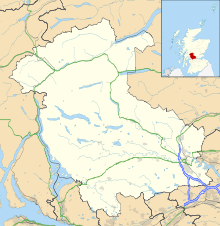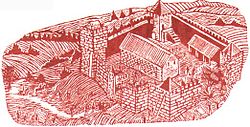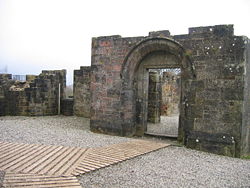- Mugdock Castle
-
Mugdock Castle Strathblane, Scotland
NS550772
The south facade of Mugdock Castle, with the single remaining towerType Courtyard castle Coordinates 55°57′56″N 4°19′28″W / 55.965556°N 4.324444°WCoordinates: 55°57′56″N 4°19′28″W / 55.965556°N 4.324444°W Built 14th century Built by David de Graham? Construction
materialsStone In use Until mid-17th century Demolished Slighted 1641 Current
conditionRuined Current
ownerStirling Council Open to
the publicYes Mugdock Castle was the stronghold of the Clan Graham from the middle of the 13th century. Its ruins are located in Mugdock Country Park, just west of the village of Mugdock in the parish of Strathblane. The castle is within the registration county of Stirlingshire, although it is only 2 km north of Milngavie, East Dunbartonshire, on the northern outskirts of Greater Glasgow.
Contents
History
The lands of Mugdock were a property of the Grahams from the mid-13th century, when David de Graham of Dundaff acquired them from the Earl of Lennox. It is possible that his descendant, Sir David de Graham (d. 1396) built the castle.[1] It was certainly standing by August 1372, when a contemporary document was signed here.[2] In 1458, the lands were erected into the Barony of Mugdock. Later, in 1505, the Grahams were created Earls of Montrose.
The most famous of the Montrose Grahams, James Graham, 1st Marquess of Montrose, may have been born at Mugdock Castle in 1612.[3] During the Bishops Wars, a prelude to the Wars of the Three Kingdoms, Montrose briefly supported the Covenanters. Montrose was imprisoned in Edinburgh in 1641, for intrigues against Archibald Campbell, 1st Marquess of Argyll, who was to become his arch-enemy. While Montrose was in prison, Lord Sinclair sacked Mugdock. Montrose returned there, however, until 1644 when he began his Royalist revolt, becoming the King's commander in Scotland. Mugdock was sacked again that year.
Following the defeat of Charles I, Montrose was executed in 1650, and the lands were forfeited to the Marquess of Argyll. In 1661 Argyll too was executed, and Mugdock was returned to the Grahams, who restored the castle over a two year period, building a mansion within the old castle walls.[4] In 1682 the Grahams bought Buchanan Old House near Drymen, a dwelling more fitting the title of "Marquess". The family's official seat was kept at Mugdock Castle for a some time.
A terraced walled garden, incorporating a summer house, was built to the east of the castle in the 1820s. In 1875, the 17th century mansion was demolished, and a Scottish baronial style house was built in the ruins of the old castle. It was designed by architect James Sellers for local historian and antiquarian James Guthrie Smith. Much of the eastern part of the original castle was destroyed in the process. During World War II the house was requisitioned for use by the government, but by 1948 was empty. It was demolished in 1967, although foundations and walls remain.
In 1981 the castle and grounds were donated by its then owner to Central Regional Council. The lands now form part of Mugdock Country Park, and the ruins are publicly accessible. The remaining tower has been renovated as a museum. The castle is a Scheduled Ancient Monument and a Category A listed building.
Architecture
The early castle
The original castle was built in the mid-14th century. It comprised four towers arranged around a courtyard, and linked by high curtain walls. In the middle of the south wall was the main gate. The castle stood on a natural, steep-sided mound formed of hard volcanic rock, at the west edge of Mugdock Loch, which was larger than its present extent.[1] Of the early castle, only the south-west tower remains complete, and forms the most recognisable feature of the ruins. The narrow tower is of four storeys, with an entrance on the first floor, accessed via exterior steps on the east side. Inside the basement is vaulted, and a single room occupies each storey. On the outside, a line of corbels projects the two upper storeys out from the lower levels, giving the tower a distinctive "top-heavy" appearance. The only other remains are the basement of the north-west tower, part of the gatehouse, and linking sections of curtain wall.
Expansion
The castle was extended in the mid-15th century, probably around the time that the barony was created. An outer wall was built to enclose the majority of the mound as an outer courtyard. This courtyard had its main entrance to the south, adjacent to the south-west tower. Inside the courtyard are the ruins of various stone buildings, mainly dating from the 16th century.[5] These include a chapel at the north extent of the courtyard, and a domestic range at the south-west. Much of the outer curtain wall has also disappeared, although the southern section remains.
The Victorian house
By the late 19th century, much of the castle was in ruins. When James Guthrie Smith built his mansion, any remains of the eastern towers were obliterated. The one surviving tower was incorporated into the new building, via a first-floor covered passage, over a wide-arched bridge. The house itself was L-shaped and three storeys high, and built in the Scottish baronial style. The front door faced the south-west tower, framing a small courtyard. The house was mostly demolished to the foundations in 1967, although some walls stand to first-floor level.
Guthrie Smith was a relative of James Smith of Jordanhill, 4th Laird of Craigend. The Smith family were retainers of the Clan Graham.[citation needed]
References
- ^ a b Lindsay, p.386
- ^ Mugdock Country Park Website
- ^ Coventry, p.327
- ^ Gazetteer for Scotland
- ^ NMRS Site Ref. NS57NW 9.00
- Coventry, Martin The Castles of Scotland (3rd Edition), Goblinshead, 2001
- Lindsay, Maurice The Castles of Scotland, Constable & Co. 1986
- Mason, Gordon The Castles of Glasgow and the Clyde, Goblinshead, 2000
- Historic Scotland Listed Building Report [1]
- National Monuments Record of Scotland Site Reference NS57NW 9.00 [2]
External links
Categories:- Castles in Stirling council area
- Category A listed buildings in Scotland
- Listed buildings in Stirling council area
- Listed castles in Scotland
- Scheduled Ancient Monuments in Scotland
- Demolished buildings and structures in Scotland
Wikimedia Foundation. 2010.



